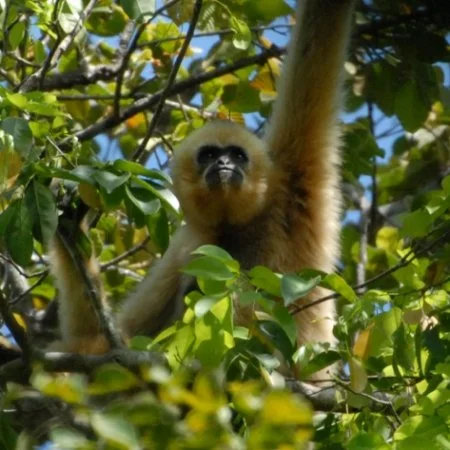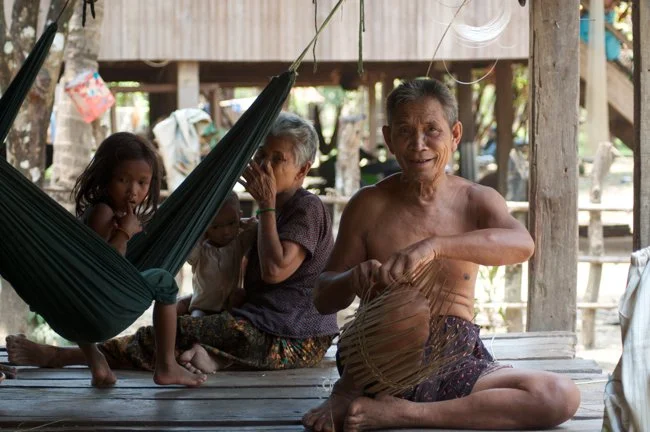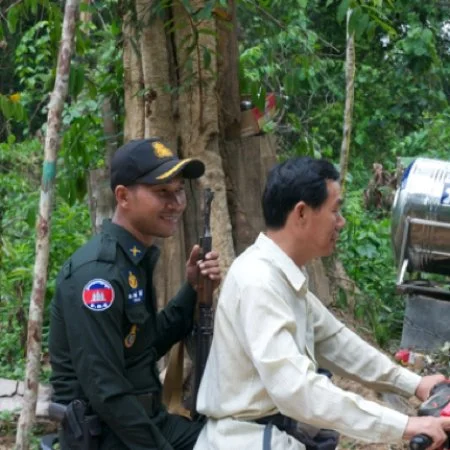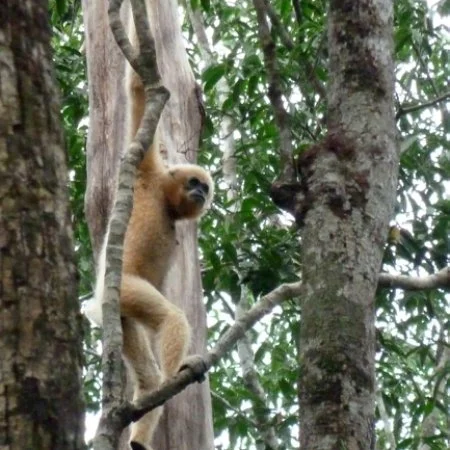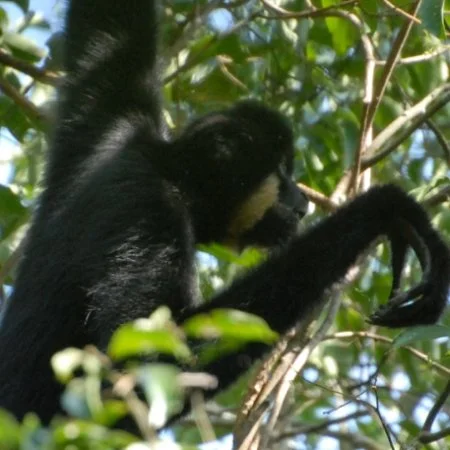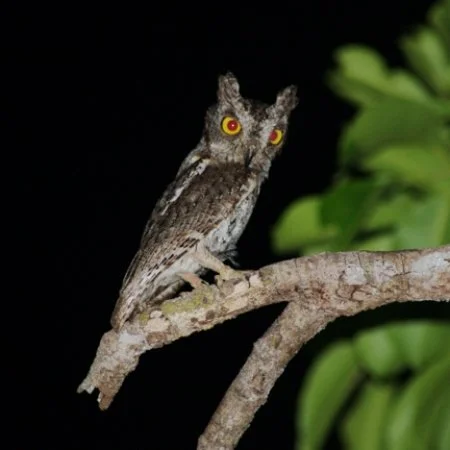The swing set
An ecotourism initiative in northeast Cambodia is aimed at saving a newly discovered species of gibbon and the unique biodiversity of its home.
South China Morning Post, 13 May 2012
Adult female northern yellow-cheeked gibbon. © Conservation International.
The first morning call goes out earlier than expected and we find ourselves racing through the forest in near darkness. Running, tripping, thorns ripping at our arms, we blindly follow the person in front and the soaring, whale-like song that sets our hearts pounding. It’s quarter to six and brightening fast when our guides finally stop and peer up at the treetops. Breathless and exhilarated we catch up and there, 30 metres above our heads, a family of northern yellow-cheeked gibbons sits, peeling bittersweet liana fruits and sucking on the juicy flesh, oblivious to the puffing and fire-ant swatting going on below them.
Gibbons, the songbird primates, are monogamous animals and the at turns eerie and excitable morning duet they sing to mark their territory can project for up to three kilometres. We watch, enthralled, then they chuck the fruit peel and swing away.
Anyone who’s been to a zoo will probably have seen gibbons in action. Their double-jointed, long-limbed agility, which enables them to swing through treetops at speeds of up to 55km/h, makes the small apes immensely popular attractions. This family of four lives in the Veun Sai-Siem Pang Conservation Area, in Ratanakiri, northeast Cambodia. The northern yellow-cheeked gibbon was only discovered by conservation groups two years ago, and it has joined a growing list of new species recorded in an area that is emerging as a biodiversity hot spot.
Members of the Laotian community living beside the conservation area. © Nicky Sullivan.
For two electrifying hours, we track the gibbons through the forest, following no path but the infallible instincts of Hake, our guide and a member of the Kavet highland tribe, in whose territory the gibbons live. Above our heads, they swing, sway, groom, play and search for fruit. The gibbons move quickly and easily, the ball and socket joint in their wrists making light work of the distances between trees, while we clamber and battle our way through the foliage below, loving every minute. It is clear whose territory we are really in.
The males’ black fur can sometimes be hard to spot, but the female sports the characteristic yellow that marks her sexual maturity. To wit, we hold our blushes as the adult pair put into action their ideas for boosting the population living in the area, which, at 540 square kilometres, is about the same size as Thailand’s Phuket.
Rangers heading out on patrol — illegal logging is a large and dangerous problem here.
The group here is small, numbering 500 families, but is nonetheless the largest of its species that is known about, so even before its ranking has been fully assessed on the International Union for Conservation of Nature’s Red List of Threatened Species, conservationists fear the gibbon is already endangered.
Banlung, the provincial capital of Ratanakiri, is nine hours by bus from Phnom Penh. The journey lays bare the extent of the problem the gibbons face. Many thousands of acres of vibrant, mixed evergreen forests have been cleared and replaced with a numbing scene of endless cashew and rubber trees. Also, the gibbons are hunted to be kept as pets and, in Vietnam, as a source of bushmeat.
We are on the first trip organised as part of a collaboration between Conservation International and two tour operators, with the support of Cambodia’s Forestry Administration. For the past two years, the groups have been working to implement a community-based eco- tourism (CBET) project aimed at preserving the habitat and, therefore, the gibbons.
Ecotourism is ultimately about the conservation of a species or habitat, and not just a visit to a pretty location, as many operators would have you believe. CBETs are a marriage of those overarching conservation goals and local communities, whose knowledge and participation are vital. The aim is to help local communities and others see the value of preserving a site.
The theory may sound woolly and tenuous, but initiatives such as this can and do work. At Tmatboey, in Preah Vihear province, a CBET project established by the Wildlife Conservation Society to protect the extremely rare giant ibis and white-shouldered ibis has seen the cancellation of four land concessions that threatened the integrity of the environment on which the birds depend.
Adult female northern yellow-cheeked gibbon. © Rik Hendricks, DutchCo.
The camp we are staying in is in the grounds of the Forestry Administration’s research station. Getting here from Banlung took five hours by road and boat, topped off with a 19-kilometre cycle ride that gave us our first insight into this particularly beautiful corner of Cambodia. Still in the early phases, the camp and accommodation are simple and basic – we sleep in hammocks, which the tour operator, See Cambodia Differently, says will be upgraded to beds soon.
The gibbons share the forest with a menagerie of sunbears, lorises, langur, squirrels, the enormous and elusive gaur (a wild cow), macaques, clouded leopards and wild dogs. Many of the species here are listed as endangered on the IUCN Red List.
From the camp, we take several trips to explore the lush environment, and each yields its own treasures.
Male gibbon. © Conservation International.
On a night hike, we search the trees for the twin orange glows of loris eyes, and find instead a flying squirrel and flying fox. We witness a spectacular “fireworks” display when we switch off our headlamps. Out of the near total darkness blooms a visual symphony of green and orange flashes: male fireflies tripping the light fantastic in the hope of attracting a mate.
The forest floor looks as though a million tiny jewels have been scattered across it. I am slightly less enchanted when I realise it is my lamplight shining off the eyes of spiders, which, for an arachnophobe, should be the trigger for a breakdown. But even they are bewitching.
We wake on the second morning to a dawn chorus like nothing I’ve ever heard before: millions of birds, and the haunting duet of a gibbon pair that live nearby. By day, the forest whistles, chirps, whirs, whines, whoops and boops at us, as butterflies dance in our path. Hake’s expert eyes seem able to see through trees, as he quietly points out lizards, squirrels, birds, a flying fox, frogs and bugs you wouldn’t want to find in your home. The forest is so incredibly alive that it is impossible to imagine it could one day not be here.
The Kavet people can’t imagine the forest not being here, either. A member of the CBET group at the camp says they could not live without it. He is waiting patiently to see whether the tribe’s commitment will bring results.
The common snopes owl. © Nicky Sullivan
They’ve always lived in harmony with the gibbons, believing them to be virtually human. That harmony has reached a new pitch as the Kavet work to help conserve the animals, and their own way of life.
Getting there: Dragonair (www.dragonair.com) flies daily from Hong Kong to Phnom Penh, which is between eight and 10 hours by road from Banlung (bus: US$9; private taxi: US$120). The tours (www.gibbonspottingcambodia.com) operate out of Banlung, and cost US$378 per person, for a minimum of three people, excluding accommodation in Banlung. (Prices may have changed).
